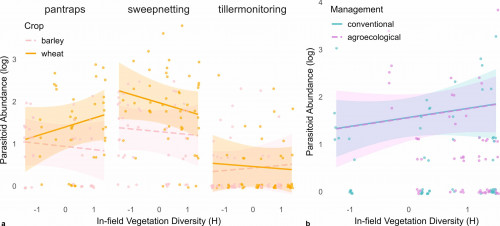Agricultural intensification has increased crop yields but caused biodiversity loss, pest outbreaks and environmental damage, threatening essential ecosystem services like natural pest control. In response, the EU and Switzerland are promoting sustainable farming practices—such as organic farming, habitat conservation and reduced pesticide use—to enhance biodiversity and ecosystem health. Biodiversity, at both field and landscape levels, supports beneficial insects that regulate pests and agroecological approaches, combining crop diversity and habitat management, which can then improve these services. However, their effectiveness depends on landscape complexity.
Hence, a SHOWCASE study, written by partner Agroscope in combination with ETH Zürich, explores how field management and landscape composition affect biodiversity, pest control and crop yields, hypothesising that biodiversity-friendly practices paired with diverse habitats can strengthen natural pest control and sustain productivity, despite reduced pesticide use.
The research monitored 30 paired agricultural fields in Canton Solothurn, Switzerland, comparing agroecological and conventional practices as part of the PestiRed project, which aims to cut pesticide use by 75% while maintaining yields. From 2022 to 2023, the study tracked pests, predators and parasitoids using life cycle-aligned monitoring. Agroecological fields avoided pesticides, using methods like mechanical weeding and wildflower strips, while conventional fields used chemical treatments. Vegetation, yields and landscape diversity (via GIS) were recorded and mixed models assessed how management, environment and predator abundance affected pests and yields using metrics like the Treatment Frequency Index and Shannon diversity.
Results showed that agroecological field margins boost vegetation diversity, but this does not always increase in-field vegetation or arthropod abundance, which vary by species and landscape context. While predator populations tended to be higher in agroecological fields, this did not lead to stronger pest suppression, revealing a complex relationship between natural enemies and pest control. Crop yields were lower under agroecological management, reflecting trade-offs between biodiversity promotion and productivity. Specifically, while pesticide applications are predictable in their effect, yield reductions could not always be averted by increased mechanical soil and weed management, used to offset pest and weed pressures in agroecological fields. Additionally, parasitoids—key natural pest controllers—remain understudied and underused in open-field agriculture, highlighting gaps in current pest management.
Overall, the findings underscore the need for long-term research and integrated strategies combining biodiversity conservation with practical farming to optimise pest regulation and crop yields in agroecological systems.
Read the full study here.
Image: Effect of vegetation diversity (Shannon Index, H) on parasitoid abundance depending on the management, sampling method, and culture across sampling rounds (i.e. each point corresponds to a sampling round). a) Effect in cereals per sampling method, b) effect on parasitoid abundance monitored using pantraps in oil seed rape (OSR).
